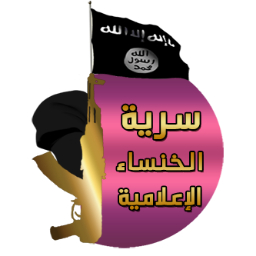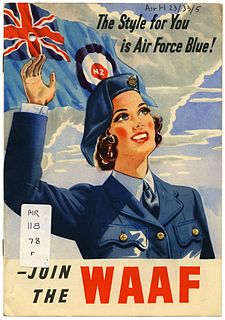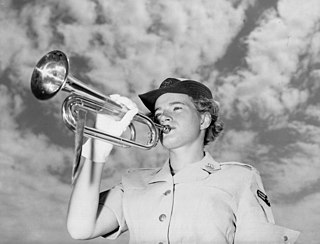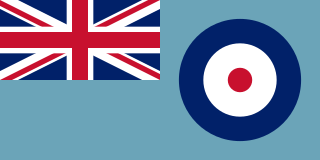 W
WThe 14th Searchlight Battery was a Finnish anti-aircraft searchlight battery formed from women of the Lotta Svärd organization at the end of the Continuation War. The battery was formed to free men for other tasks and was used in the air-defence of Helsinki. The battery was the only armed unit in Finnish Army made up from women that was organized as a military unit fit for combat duty. The searchlight battery was operational from late summer 1944 to the end of the Continuation War but did not see action.
 W
WThe 125th Guards Bomber Aviation Regiment was one of the three Soviet women's aviation regiments founded by Marina Raskova at the start of the Second World War. The unit was founded as the 587th Bomber Aviation Regiment in the 223rd Bomber Air Division, 2nd Bomber Aviation Corps of the 16th Air Army on 8 October 1941, and later honored with the guards designation, being renamed 125th Guards Bomber Aviation Regiment in September 1943 and reorganized into 4th Guards Bomber Aviation Division, 1st Bomber Aviation Corps, 3rd Air Army, in the 1st Baltic Front. Unlike the 46th Taman Guards Night Bomber Aviation Regiment, which used Polikarpov Po-2 utility aircraft, the unit was assigned modern Petlyakov Pe-2 aircraft, which caused some resentment among male units that had older aircraft. Throughout the course of the war, the unit flew 1,134 missions and dropped over 980 tons of bombs on the Axis.
 W
WThe 6888th Central Postal Directory Battalion, nicknamed the "Six Triple Eight", was an all-black battalion of the Women's Army Corps (WAC). The 6888th had 855 black women, both enlisted and officers, and was led by Major Charity Adams Earley. It was the only all-black, all-female battalion overseas during World War II. The group motto was "No mail, low morale".
 W
WThe Al-Khansaa Brigade is an all-women police or religious enforcement unit of the extremist self-proclaimed jihadist group Islamic State of Iraq and the Levant (ISIL), operating in its de facto capital of Raqqa and Mosul. Formed in early 2014 and apparently named after Al-Khansa, a female Arabic poet from the earliest days of Islam, it is unclear how widespread and sustained the group is. It is unique in the Muslim world where in other regimes with similar systems of religious police men enforce hisbah among women, and in the Islamic State has not spread outside of the capital Raqqa, leading one observer to wonder if it is a publicity "stunt" that will be “short-lived".
 W
WThe Australian Women's Army Service (AWAS) was a non-medical women's service established in Australia during the Second World War. Raised on 13 August 1941 to "release men from certain military duties for employment in fighting units" the service grew to over 20,000-strong and provided personnel to fill various roles including administration, driving, catering, signals and intelligence. Following the end of the Second World War, the service was demobilised and ceased to exist by 1947. It later provided a cadre of experienced personnel to the Women's Royal Australian Army Corps when it was established in 1951.
 W
WThe Auxiliary Territorial Service was the women's branch of the British Army during the Second World War. It was formed on 9 September 1938, initially as a women's voluntary service, and existed until 1 February 1949, when it was merged into the Women's Royal Army Corps.
 W
WThe Bethnahrain Women's Protection Forces is an all-female Assyrian military and police organization based in al-Qahtaniyah, al-Hasakah Governorate, Syria.
 W
WThe Canadian Women's Army Corps was a non-combatant branch of the Canadian Army for women, established during the Second World War, with the purpose of releasing men from those non-combatant roles in the Canadian armed forces as part of expanding Canada's war effort. Most women served in Canada but some served overseas, most in roles such as secretaries, mechanics, cooks and so on. The CWAC was finally abolished as a separate corps in 1964 when women were fully integrated into the Canadian armed forces. The headquarters of the CWAC was based in Goodwin House in Ottawa.
 W
WThe Mino, or Minon, which means "our mothers", or so-called Dahomey Amazons by European writers, were a Fon all-female military regiment of the Kingdom of Dahomey in the present-day Republic of Benin which lasted until 1904. They were so named by Western observers and historians due to their similarity to the mythical Amazons of ancient Anatolia and the Black Sea.
 W
WThe Emilia Plater Independent Women's Battalion was a unit of the Soviet First Polish Army during the Second World War. Formed in 1943 it was intended as a front-line combat unit but was relegated mainly to police and sentry duty. It existed until the end of the war in May 1945, whereupon it comprised 500 members.
 W
WThe Êzîdxan Women's Units is a Yazidi all-women militia formed in Iraq in 2015 to protect the Yazidi community in the wake of attacks by the Islamic State of Iraq and the Levant and other Islamist groups that view Yazidis as pagan infidels.
 W
WFemale Engagement Teams (FETs) are groups of female military personnel around the world which undertake specialized gender-suited tasks. FETs' tasks are as varied as American FETs interacting with local Afghan women in Afghanistan; Ghana Battalion FETs taking part in gathering intelligence during peacekeeping operations in the Democratic Republic of Congo; New Zealand Defence Force FETs support Special Operations Force objectives, the primary role being to "engage with local women and adolescents [...] in situations where it would be culturally unacceptable to involve male SOF operators", and the Jordanian Armed Forces FETs helping to conduct physical searches of woman along the borders. However FETs also have had their fair share of limited success and problems in certain operations, with service personnel unable to interact successfully with the required population, lack of translators, too short a time frame or commanders refusing to take up FET missions.
 W
WAll-female units of the paramilitary Red Guards served in the 1918 Finnish Civil War. The first Women's Guards units formed in early February in the main Finnish cities. More than 15 female Guards units were established by the end of March 1918, with a total of about 2,000 women serving. The female Guards units consisted of young industrial workers, maids, and servants. Their average age was about 20, but some were as young as 14. The women served in auxiliary units and in combat.
 W
WThe Krom Klone were the all-female bodyguard of the King of Siam. They were established in 1688 and were a well-disciplined force, responsible for the security of the royal family and the maintenance of order within the palace grounds.
 W
WThe Women's Auxiliary Air Force was the female auxiliary of the Royal New Zealand Air Force during the Second World War. Established in 1941, it began with an initial draft of 200 women, reaching a peak strength of about 3,800, with a total of about 4,750 women passing through its ranks, of who more than 100 achieved commissioned officer rank.
 W
W"Night Witches" was a World War II German nickname for the all female military aviators of the 588th Night Bomber Regiment, known later as the 46th "Taman" Guards Night Bomber Aviation Regiment, of the Soviet Air Forces. Though women were initially barred from combat, Major Marina Raskova used her position and personal contacts with the Chairman of the Council of People's Commissars, Joseph Stalin, to obtain permission to form female combat units. On October 8, 1941, an order was issued to deploy three women's air-force units, including the 588th Regiment. The regiment, formed by Major Marina Raskova and led by Major Yevdokiya Bershanskaya, comprised primarily female volunteers in their late teens and early twenties.
The Rani of Jhansi Regiment was the Women's Regiment of the Indian National Army, the armed force formed by Indian nationalists in 1942 in Southeast Asia with the aim of overthrowing the British Raj in colonial India, with Japanese assistance. It was one of the very few all-female combat regiments of the Second World War on any side. Led by Captain Lakshmi Swaminathan, the unit was raised in July 1943 with volunteers from the expatriate Indian population in Southeast Asia. The unit was named the Rani of Jhansi Regiment after Lakshmibai, Rani of Jhansi.
 W
WThe Royal Canadian Air Force Women's Division was a non-combatant element of the Royal Canadian Air Force (RCAF) which was active during the Second World War. The Women's Division's original role was to replace male air force personnel so that they would be available for combat-related duties. First called the Canadian Women's Auxiliary Air Force (CWAAF), the name changed to Royal Canadian Air Force Women's Division in February 1942. Women's Division personnel were commonly known as WDs.
 W
WThe Sacred Twenty were a group of nurses who were the first female members to ever formally serve in the United States Navy representing the Nurse Corps. Officially formed in 1908, the Sacred Twenty made broad contributions during wartime, not only including training of field nurses and disease treatment, but also providing education programs for nurses abroad and professional publications to the field of nursing.
 W
WThe Sri Lanka Air Force Women's Wing was formed in 1983 which contains the female members of the air force, both airwomen and lady officers. Only unmarried women may join. Members of this wing serve in the same roles as their male counterparts, including combat roles. Women were first admitted to the Sri Lanka Air Force in 1972 when female officers joined the Volunteer Air Force. The Women's Wing was formed on 27 February 1983 with the assistance of Women's Royal Air Force (Britain). Initially, women could not become pilots. However, in 1998 women were recruited to train for the elite pilots' wing to replace losses to the Tamil Tigers in their insurgency. 800 women applied for the 33 available places to fly transport planes.
The Sri Lanka Army Women's Corps (SLAWC) is a Sri Lanka Army regiment. The headquarters of this corps is in Colombo and the corps has seven battalions.
 W
WThe Swedish Women's Voluntary Defence Organization is an auxiliary defence organization of the Swedish Home Guard, a part of the Swedish Armed Forces.
 W
WUnited States Marine Corps Women's Reserve (Reserve) was the World War II women's branch of the United States Marine Corps Reserve. It was authorized by the U.S. Congress and signed into law by President Franklin D. Roosevelt on 30 July 1942. Its purpose was to release officers and men for combat, and to replace them with women in U.S. shore stations for the duration of the war, plus six months. Ruth Cheney Streeter was appointed the first director. The Reserve did not have an official nickname, as did the other World War II women's military services.
 W
WThe White Squadron or Escadrila 108 Transport uşor was a Royal Romanian Air Force squadron of air ambulances piloted by women in the World War II. They flew Polish RWD 13S planes.
 W
WWomen in the Air Force (WAF) was a program which served to bring women into limited roles in the United States Air Force. WAF was formed in 1948 when President Truman signed the Women's Armed Services Integration Act, allowing women to serve directly in the military. The WAF program ended in 1976 when women were accepted into the USAF on an equal basis with men.
 W
WWomen's Air Raid Defense (WARD) was a World War II civilian organization that worked with the military to provide air defense for Hawaii. It formed in December 1941 after the attack on Pearl Harbor. Women volunteered in order to allow men to be freed from air defense work to go onto combat roles. WARD was the only civilian organization employed by the military for the purpose to replace men in active duty. It was disbanded after the end of WWII.
 W
WThe Women's Army Corps (WAC) was the women's branch of the United States Army. It was created as an auxiliary unit, the Women's Army Auxiliary Corps (WAAC) on 15 May 1942 by Public Law 554, and converted to an active duty status in the Army of the United States as the WAC on 1 July 1943. Its first director was Oveta Culp Hobby, a prominent woman in Texas society. The WAC was disbanded in 1978, and all units were integrated with male units.
 W
WThe Women's Auxiliary Air Force (WAAF), whose members were referred to as WAAFs, was the female auxiliary of the Royal Air Force during World War II. Established in 1939, WAAF numbers exceeded 180,000 at its peak strength in 1943, with over 2,000 women enlisting per week.
 W
WThe Women's Auxiliary Australian Air Force (WAAAF) was formed in March 1941, after considerable lobbying by women keen to serve and by the Chief of the Air Staff, who wanted to release male personnel serving in Australia for service overseas. The WAAAF was the first and largest of the wartime Australian women's services. It was disbanded in December 1947.
 W
WThe Women's Auxiliary Service (Burma) also known as the Chinthe Women because of the mythological creature that formed their badge. The unit was formed on 16 January 1942 and disbanded in 1946. They were a 250 strong group of British and Australian women who manned Mobile Canteens for the troops of Burma Command in World War II. They were founded and led by Mrs Ninian Taylor, who was granted the rank of Major and her services were an OBE for her services
 W
WWomen's Battalions (Russia) were all-female combat units formed after the February Revolution by the Russian Provisional Government, in a last-ditch effort to inspire the mass of war-weary soldiers to continue fighting in World War I.
 W
WThe Women's Protection Units or Women's Defense Units is an all-female militia involved in the Syrian civil war. The YPJ is part of the Syrian Democratic Forces, the armed forces of Rojava, and is closely affiliated with the male-led YPG. While the YPJ is mainly made up of Kurds, it also includes women from other ethnic groups in Northern Syria.
 W
WThe Women's Radio Corps (WRC) was established by Edna Owen and an advisory council during World War One. The aim of this branch of the US Army Signal Corps was to recruit women to train as wireless operators, in order to replace male wireless operators who had gone to war. The activities of the Corps converged with the wartime wireless activities and training of the National League for Women's Service whose training classes were directed by Owen.
 W
WThe Women's Royal Air Force (WRAF) was the women's branch of the Royal Air Force. It existed in two separate incarnations: the Women's Royal Air Force from 1918 to 1920 and the Women's Royal Air Force from 1949 to 1994.
 W
WThe Women's Royal Air Force (WRAF) was the women's branch of the Royal Air Force from 1918 to 1920. Its original intent was to provide female mechanics in order to free up men for service in World War I. However, the organization saw huge enrollment, with women volunteering for positions as drivers and mechanics and filling other wartime needs.
 W
WThe Women's Royal Australian Naval Service (WRANS) was the women's branch of the Royal Australian Navy (RAN). In 1941, fourteen members of the civilian Women's Emergency Signalling Corps (WESC) were recruited for wireless telegraphy work at the Royal Australian Navy Wireless/Transmitting Station Canberra, as part of a trial to free up men for service aboard ships. Although the RAN and the Australian government were initially reluctant to support the idea, the demand for seagoing personnel imposed by the Pacific War saw the WRANS formally established as a women's auxiliary service in 1942. The surge in recruitment led to the development of an internal officer corps. Over the course of World War II, over 3,000 women served in the WRANS.
 W
WThe Women's Royal Canadian Naval Service was an element of the Royal Canadian Navy that was active during the Second World War and post-war as part of the Royal Canadian Naval Reserve until unification in 1968. The WRCNS was in operation from October 1942 to August 1946.
 W
WThe Women's Royal Naval Service was the women's branch of the United Kingdom's Royal Navy. First formed in 1917 for the First World War, it was disbanded in 1919, then revived in 1939 at the beginning of the Second World War, remaining active until integrated into the Royal Navy in 1993. WRNS included cooks, clerks, wireless telegraphists, radar plotters, weapons analysts, range assessors, electricians and air mechanics.
 W
WThe Women's Auxiliary Air Force was the female auxiliary of the Royal New Zealand Air Force during the Second World War. Established in 1941, it began with an initial draft of 200 women, reaching a peak strength of about 3,800, with a total of about 4,750 women passing through its ranks, of who more than 100 achieved commissioned officer rank.
 W
WXochitl Pronunciation(r. 877-916) was a Toltec Queen and wife of Tecpancaltzin Iztaccaltzin. Her existence beyond legend is questionable, and accounts of her life are mainly based on the writings of indigenous historian Fernando de Alva Ixtlilxochitl.